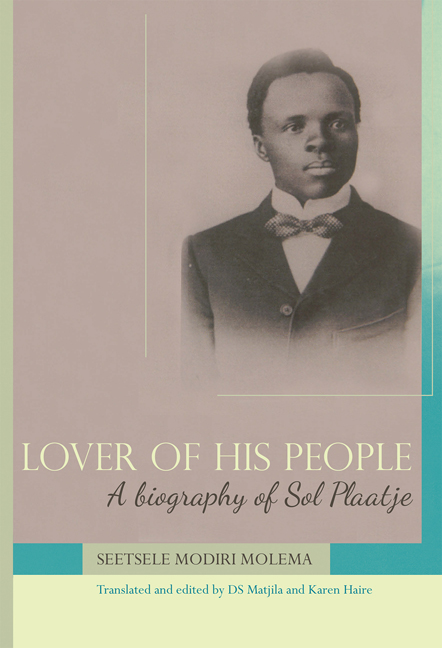Book contents
- Frontmatter
- Contents
- Acknowledgements
- Preface
- Foreword: Seetsele ModiriMolema: A star
- Chapter One First Encounter and Acquaintance
- Chapter Two Early Days and Youth
- Chapter Three An Unforgettable Year: 1896
- Chapter Four Life's Challenges
- Chapter Five Plaatje, The Career Journalist
- Chapter Six Government News
- Chapter Seven Conventions and Writings
- Chapter Eight Delegations and Meetings
- Chapter Nine Last Meetings and Travels
- Chapter Ten The Last Encounter
- Chapter Eleven Plaatje in His Own Words: English Extracts
- Chapter Twelve Plaatje in His Own Words: Setswana Extracts
- Seetsele Modiri Molema of the Mahikeng Molemas
- Bibliography
Chapter Eight - Delegations and Meetings
Published online by Cambridge University Press: 16 March 2018
- Frontmatter
- Contents
- Acknowledgements
- Preface
- Foreword: Seetsele ModiriMolema: A star
- Chapter One First Encounter and Acquaintance
- Chapter Two Early Days and Youth
- Chapter Three An Unforgettable Year: 1896
- Chapter Four Life's Challenges
- Chapter Five Plaatje, The Career Journalist
- Chapter Six Government News
- Chapter Seven Conventions and Writings
- Chapter Eight Delegations and Meetings
- Chapter Nine Last Meetings and Travels
- Chapter Ten The Last Encounter
- Chapter Eleven Plaatje in His Own Words: English Extracts
- Chapter Twelve Plaatje in His Own Words: Setswana Extracts
- Seetsele Modiri Molema of the Mahikeng Molemas
- Bibliography
Summary
CANADA AND THE UNITED STATES
After overcoming the obstacles to obtaining his passport, Plaatje left England for Canada and the United States of America in October 1920. His purpose was to observe and compare the conditions of life for blacks in America with South Africa. He disembarked in Quebec and proceeded to Toronto. The city of Toronto had a university where the great Dr Mahlangeni had studied medicine. Plaatje spent two months in Canada, hosted by black people, and in particular he enjoyed the hospitality of the Brotherhood Movement which had extended hospitality to him in England. Plaatje addressed many gatherings there and blacks in Canada even raised five hundred pounds to pay for his stay in a hotel.
From the city of Toronto, Plaatje proceeded to Buffalo in the United States of America, where he had been invited to address many organisations. There, too, he received gifts of money. Plaatje then proceeded to a number of major cities including New York, Chicago and Washington. While in New York, Plaatje visited Harlem, known to be the largest black city in the world. One section of Harlem was full of beautiful wealthy homes, shops, magnificent churches, plush theatres, hotels, banks and such. The other section was dirty, overcrowded, poverty-ridden, disease-ridden and noise-ridden; full of dilapidated buildings, and drunkenness and substance abuse were conspicuous everywhere. Notwithstanding all of the above, it was evident that the people were free.
From New York, Plaatje proceeded to the southern states that had large black populations: Mississippi, Alabama, Louisiana, Georgia, Kentucky and Tennessee. While he was there he visited well-known black educational institutions, Tuskegee College and the Universities of Fisk, Hampton, Howard and Wilberforce. He also met the civil rights leaders Dr WEB Du Bois, Marcus Garvey, Professor Kelly Miller and others. When Plaatje returned to South Africa, he said that the southern states of the US were like the northern regions of South Africa, the Orange Free State and the Transvaal, in that there were many laws there segregating and discriminating against blacks, but he said that in spite of this it was in the southern states that the most hard-working black people lived – carpenters, builders and tradesmen. Plaatje went on to compare the northern states of the US with the southern region of South Africa, Cape Colony, where blacks were free in all areas of life.
- Type
- Chapter
- Information
- Lover of his PeopleA biography of Sol Plaatje, pp. 73 - 79Publisher: Wits University PressPrint publication year: 2013



